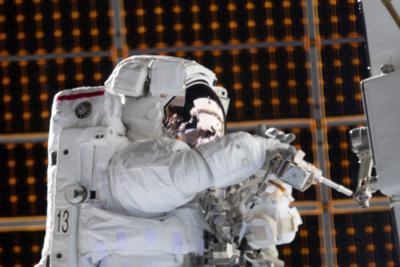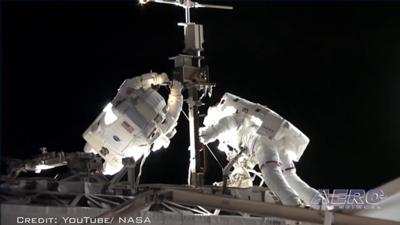Tue, Jun 16, 2020
The Spacewalks Will Continue Power Upgrades Begun Last Year
The Expedition 63 crew is starting the week getting ready for a pair of upcoming spacewalks and a satellite deployment. The International Space Station residents are also setting up research gear that will analyze hazardous particles and plasma crystals.

The three NASA astronauts onboard the station teamed up today setting up hardware and reviewing plans for two spacewalks planned to start at the end of the month. Commander Chris Cassidy and Flight Engineer Bob Behnken checked out rechargeable batteries that will power up U.S. spacesuit components. Flight Engineer Doug Hurley looked at procedures to put on the spacesuits as well as steps a spacewalker would take during an emergency.
The spacewalks will continue power upgrades begun last year on the outside of the space station. Cassidy and Behnken will replace old nickel-hydrogen batteries with new lithium-ion batteries on the Starboard-6 truss segment. The batteries store and distribute power collected from the solar arrays throughout the station.
Cassidy started Monday in Japan’s Kibo laboratory module readying a 110-kilogram Red-Eye satellite for deployment in the next couple of weeks. He installed the satellite inside Kibo’s airlock where it will be placed into the vacuum of space and ejected into orbit from the NanoRacks Kaber Microsat deployer. Red-Eye, the second of three microsatellites, will test satellite communications, flight computers and thermal management technologies.

Behnken helped out with the Red-Eye work before installing the new Mochii microscope in the Kibo lab where it will analyze particles that could threaten crew health and spacecraft safety. Hurley worked in the European Columbus laboratory module making room for the new European Drawer Rack-2 that will support a variety of new space experiments.
The two cosmonauts in the Russian segment of the station kept up their schedule of microgravity research and life support operations. Veteran Flight Engineer Anatoly Ivanishin serviced hardware that observes plasma crystals which could lead to improved research methods and new spacecraft designs. First time space-flyer Ivan Vagner checked space radiation readings and set up Earth observation hardware.
More News
From 2021: The Inside Skinny On What Being An ANN Oshkosh Stringer Is All About By ANN Senior Stringer Extraordinare, Gene Yarbrough The annual gathering at Oshkosh is a right of p>[...]
Video Showed That During The Takeoff, The Nose Baggage Door Was Open On May 10, 2025, about 0935 eastern daylight time, a Piper PA-32RT-300, N30689, was destroyed when it was invol>[...]
Get The Latest in Aviation News NOW on Instagram Are you on Instagram yet? It's been around for a few years, quietly picking up traction mostly thanks to everybody's new obsession >[...]
"I think what is key, we have offered a bonus to air traffic controllers who are eligible to retire. We are going to pay them a 20% bonus on their salary to stay longer. Don't reti>[...]
Aero Linx: Pilot Briefing The gathering, translation, interpretation, and summarization of weather and aeronautical information into a form usable by the pilot or flight supervisor>[...]
 Oshkosh Memories: An Aero-News Stringer Perspective
Oshkosh Memories: An Aero-News Stringer Perspective NTSB Prelim: Piper PA32RT
NTSB Prelim: Piper PA32RT ANN FAQ: Follow Us On Instagram!
ANN FAQ: Follow Us On Instagram! Aero-News: Quote of the Day (05.28.25)
Aero-News: Quote of the Day (05.28.25) ANN's Daily Aero-Term (05.28.25): Pilot Briefing
ANN's Daily Aero-Term (05.28.25): Pilot Briefing




